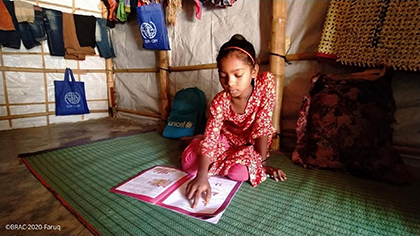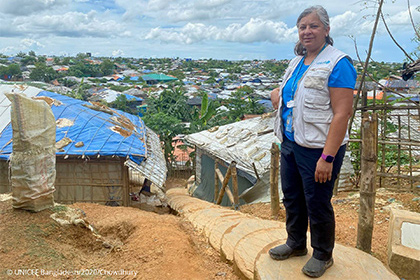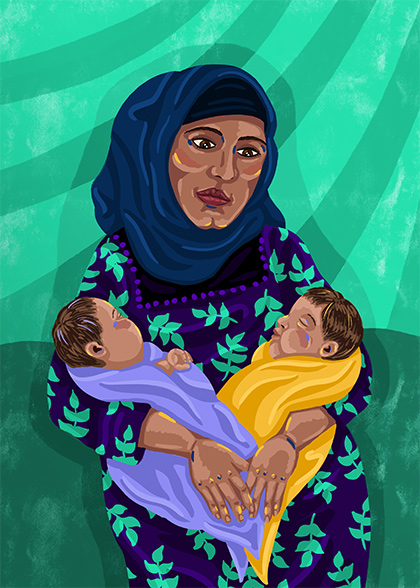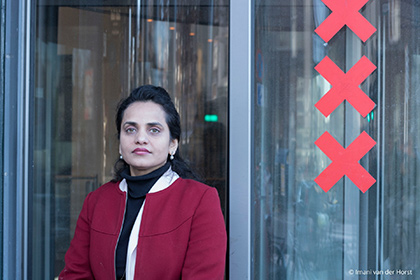For refugees, pandemic brings one emergency within another

When home is a shelter without electricity in the world’s largest and most densely populated refugee camp, adapting to the new reality is a particular challenge.
Like many children around the world, Shefuka is learning at home, with her school shuttered by the COVID-19 pandemic. But when home is a shelter without electricity in the world’s largest and most densely populated refugee camp, adapting to this new reality is a particular challenge.
Nine-year-old Shefuka lives with her mother, Fatema, and 3 siblings in the Rohingya settlement in Cox’s Bazar, Bangladesh, which closed its learning centres in March to minimize the risk of a COVID-19 outbreak, affecting more than 300,000 children.

“I feel very sad that I cannot continue my studies like before,”
Shefuka says. “I read books, draw pictures and play the games we learned at our learning centre with my brother and sisters. But I feel bored staying at home all the time.”
Her lament is familiar to parents everywhere. But it highlights the complexities of the global health crisis for refugees such as the 860,000 Rohingya of Cox’s Bazar, who have fled atrocities in Myanmar. Virus mitigation measures at the camp have erased meagre incomes, stalled vital humanitarian services and closed some “safe spaces”
for women and girls, bringing rising rates of gender-based violence, prostitution and child marriage. Meanwhile, COVID-19 threatens to surge in the cramped conditions.
“Within 1 emergency we have another emergency,”
says Shairose Mawji, a Canadian who is chief of field services for UNICEF Bangladesh and is currently officer in charge of UNICEF operations at Cox’s Bazar.

UNICEF, with the support of Canada, has implemented home-based learning programs in Cox’s Bazar to help children like Shefuka and their families. For example, Rohingya volunteer teachers make visits to assist children, parents and caregivers with their studies while the learning centres are closed, using picture guides and workbooks.
They also deliver advice on handwashing and hygiene to prevent COVID-19. Other information-sharing and community engagement efforts at the camp include messages about how to stay safe from the virus. The messages are broadcast in radio spots and from tuk-tuks, motorized vehicles that rove the sprawling camp.
“We’re doing as much as we can to save lives,”
says Mawji, a native of Vancouver, British Columbia, who is a nurse-midwife. She notes that reported rates of COVID-19 are low in the camp, but relatively high in Bangladesh with 2,500 to 4,000 new cases a day in the country of 164 million.
Adapting to the pandemic
The UN Refugee Agency reports that three quarters of the 26 million refugees in the world live in developing countries that have some of the weakest health systems in the world. Another 40 million internally displaced people live in similar difficult circumstances.
For example, 5.5 million Syrian refugees, the biggest group of refugees in the world, are struggling under social and economic constraints imposed by the crisis. Jordan currently hosts some 1.3 million Syrians, including more than 650,000 registered refugees, 80% of them living outside camps, according to the International Rescue Committee (IRC), a partner of Canada in the region.
Bryn Boyce, a Canadian who is deputy director of programs for the IRC in Jordan, says the organization has adapted its programming under the pandemic. For instance, technology is increasingly serving as its “eyes and ears on the ground,”
he says, allowing the IRC to remain connected to evolving needs and deliver reproductive health, primary health and gender-based violence response services supported by Canada. Remote delivery of services through WhatsApp and other channels fills a gap, “but it’s not the same as face-to-face interaction,”
he says, particularly when responding to high-risk cases.
“Providing support to survivors of gender-based violence over the phone, in their homes, is just not the same,”
explains Boyce, who has been working in Jordan for 6 years. He says 1 of the biggest stressors of the pandemic for marginalized people, such as refugees, is that they’ve had to forgo the patchwork of small jobs they need to get ahead or even survive. This economic pressure on households is increasingly contributing to violence in them.
“We’ve seen a significant decline in refugee resilience,”
he says. “Already-vulnerable households are more so. They’re back to square one or worse.”
With this decline in fortunes, “that’s a huge investment from Jordan and the international community lost—or put in peril—as COVID-19 erases gains that had been made,”
Boyce comments. Funding to support the basic needs of refugees does not always keep pace with demand. And while refugee camps did not face any outbreaks in the first wave, there have been confirmed cases more recently in Jordan’s largest refugee camp, Zaatari, and in the smaller Azraq camp. Between them, the 2 camps are home to approximately 115,000 people.
Assistance from Canada is helping to bridge the gap, Boyce says, “because no one is safe from COVID-19 until everyone is.”
Indeed, people in Jordan are struggling with many of the same uncertainties and restrictions as Canadians but with fewer resources. “There’s a lot more that connects than divides us when it comes to this pandemic,”
he remarks.
Bright spots amidst the challenges

“For most refugees, COVID-19 is an additional complexity in an already complex situation,”
Boyce says, noting there are bright spots amidst the challenges. One woman, who was pregnant in her ninth month with twins, was supported by the IRC to reach Irbid Speciality Hospital and safely give birth. “That was a touchstone moment,”
he recalls. “It was a wonderful story inside an otherwise dark period.”
Refugees themselves are organizing to deal with the challenges of COVID-19. This past summer, the Global Independent Refugee Women Leaders (GIRWL) network hosted a virtual conference focused on the impact and opportunities of the pandemic for refugee women. It was supported by the World Refugee and Migration Council, chaired by Canada’s Lloyd Axworthy. Participants included refugee women from around the world, as well as former U.S. secretary of state Madeleine Albright; Marco Mendicino, Canada’s Minister of Immigration, Refugees and Citizenship; and Jacqueline O’Neil, Canada’s Ambassador for Women, Peace and Security.
“Amplifying refugee women's voices goes beyond storytelling,”
explains Wazefadost. “It's about recognizing their skills and expertise about their own situations.”
Attendees heard that the biggest problem for refugees and asylum-seekers is a lack of access to vital information about COVID-19, with many social services now delivered remotely. Meanwhile, most refugee children do not have technology for remote schooling or parents who can guide them in its use, and there are rising concerns about job losses, homelessness and mental-health issues.

“Domestic violence also increases, as self-isolation may mean staying in a home that is not safe,”
says Wazefadost.
Adds Noor, “Refugee women have fewer resources to deal with the economic impacts of lockdowns and less access to medical and government services, and they don’t have the privilege of practising social distancing. But still they are taking the lead and showing their resilience, which we should acknowledge.”
At Cox’s Bazar, the 2020 COVID-19 Response Plan calls for a total of $570 million for activities that include scaling up water and sanitation facilities, providing additional food to combat malnutrition and creating isolation wards. Shairose Mawji says some 1,500 beds are available to treat those with mild to severe COVID-19 symptoms.
Refugees play an important role
The Rohingya themselves play an important role in individual counselling and communication efforts surrounding the pandemic, Mawji says. And they’re being trained to provide home-based advice and care for COVID-19 patients if treatment facilities reach capacity.
She points to the camp’s home-based education programs as an important way the refugees are adapting to the COVID-19 constraints. It gives Mawji hope for the future. Like many educators around the world, she says, those at Cox’s Bazar are asking themselves how to help children learn better despite the pandemic.
Possible solutions include staggering classes in the learning centres and finding ways that children can return to lessons remotely, despite limited electricity and technology; for example, via radio or lessons pre-loaded onto computer tablets. “We have to teach in a different way,”
she says.
Doing things differently is a major lesson of the COVID-19 crisis for vulnerable people, like the Rohingya refugees, Mawji says. “These people left their country with nothing. Their situation has been dire and continues to become even more difficult. COVID-19 is just an added challenge they face.”
A compilation of problems—and ideas
Phedra Moon Morris, Canada’s head of aid in Bangladesh, says that transmission rates of the disease have been kept relatively low among Rohingya refugees, “but there’s no expectation that we’ll be able to maintain that.”
Testing levels are low, and those infected with COVID-19 hide their symptoms out of fear they will be removed or stigmatized, she explains. “You’re dealing with refugees who have been highly traumatized after experiencing unimaginable horrors.”
Ambitious goals for the Cox’s Bazar camp include increasing the number of humanitarian workers on the front lines, which has been limited. Those who continue to work there “are exhausted and way over-rotated,”
and are thus prone to burnout and at higher risk of infection, Morris says. But they’re fearful of taking breaks because they may not be allowed back in. Canada and its aid partners have asked for a “humanitarian air-bridge”
to bring more supplies and personnel.
This “compilation of problems”
is not new to refugees, Morris comments, but their lives and the efforts of humanitarian partners, such as Canada, are substantially more difficult under COVID-19.
“These people have dealt with so many challenges in the past,”
she adds. “But if we have the resources, they have the ideas.”
- Date Modified: